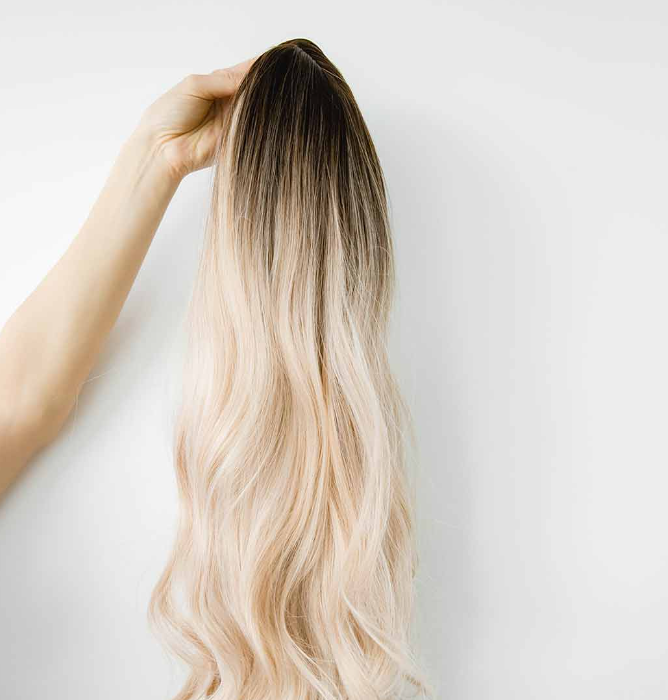Clip, tape, braid, pre-bond, fuse, microlink… What does all this mean? There are so many different styles of hair extensions and terminology that if you are new to hair extensions, it can be overwhelming. While Luxury hair extensions are 100% Remy’s hair clips, hair extensions are not limited to this type. We’ll categorize the different types of extensions to help clear up some of the confusion.
The following article will provide clear ideas to help you make the best choice for your hair. Sit comfortably, tie your hair back, and let’s get started.
Natural human hair extensions vs. synthetic hair extensions
The first thing you need to understand before getting into the different hair extension application methods is that they have both human and synthetic hair extensions. So, what’s the difference between them?

How to get hair extensions
Human hair extensions are just like the name. They are made from head to toe from natural human hair collected from donors. Remy’s hair means that all the cuticles (the outer layer of the hair) are intact and run in the same direction at the time of collection. This allows for almost no knotting and ensures the extension remains smooth and silks throughout its life cycle.
On the other hand, artificial hair is made from a mixture of various synthetic fibers and does not contain human hair. These are usually fabulous plastic fibers made to mimic natural human hair.
Look and feel
Both natural and synthetic extensions have many styles, colors, and application forms. Synthetic fibers vary in quality, but they are often challenging and move differently than human hair, so they don’t mix well with your natural hair. They sometimes feel wire or rough. Real hair looks and feels natural (because it is!). So it blends in more naturally with your hair.
Color and shape
Human hair extensions can be treated like your own natural hair. You can straighten, curl, blow dry, color, and use hair products. You can’t color artificial hair because most dyes contain ammonia or bleach, which can ruin the synthetic hair. Also, artificial hair can’t be styled the same as natural hair because heat can damage artificial hair, so don’t use curlers, straighteners, and hair dryers, as they can melt or seriously damage hair. Other factors, such as sunlight, friction, or rough hair products, can damage synthetic hair extensions.

The quality and duration of hair extensions
Synthetic hair is cheaper than natural hair, of course, at a price. Because they are made of synthetic fibers, they do not last as long as human hair because they are easily damaged by the factors mentioned above (sunlight, heat, etc.). In general, synthetic hair extensions can last a few months, while human hair extensions can last more than a year if taken care of well. Luxy Hair Remy, a human hair extension, lasts about a year.
Human hair, when used for extensions, can be treated and styled just like your own hair, resulting in a natural look and feel. It seamlessly blends with your hair and has a longer lifespan compared to synthetic hair. While synthetic hair is more affordable, it lacks the natural look, versatility, and durability of real hair.
Now that we’ve explored the world of hair extensions let’s dive into the next exciting chapter: the different types of extension applications!

1. Cut in extensions
What are they?
A clip-in weft, also known as a clip-in hair extension, is a strand of contouring that attaches fabric or silicone to the bottom. Clips are attached to this base and ready for use. All you have to do is cut your hair into your own! Each clip can be opened and closed quickly – see how to clamp them here.
Clip-in hair extensions are the least durable because you can take them off and put them back on at any time. Unlike some other hair extension apps mentioned above, using the clip at home usually takes 5-15 minutes. Clip-in extensions are also the least damaging because they don’t involve any chemicals, heat, pressure, or other installation methods mentioned above – they clip into your hair quickly, so they don’t harm your natural hair. This is one of the many reasons why it is one of the most popular hair extension types.
The same rules for artificial and natural hair apply to the treatment of clip-in hair extensions, just like any hair extensions. We will focus more on human hair extensions because that’s what we recommend.
Simply put, human hair extensions need to be improved maintenance and only be cleaned every 15-20 times or if there is a lot of product piling up to the point where it is difficult to manage. Like your natural hair, you brush, wash, condition, and let it air dry! See here for step-by-step instructions and tips on how to clean and care for your hairpin extensions. In terms of styling, extensions of human barrettes can be designed like your own natural hair. They can be curled, straightened, and colored. However, using a lower heat setting when heat styling your hair is best, and using a heat protectant before heat styling. Click here to learn about heat-setting human hairpin extensions and some hair coloring tips.
How long can they last?
Again, it depends on how you take care of them, what products you use, and how often you use them. With proper care and regular wear, clips can last 3-6 months, up to a year, and sometimes even longer. Check out here for care tips and tricks to ensure your hair stays sweet for a long time.
Luxury Hair offers high-quality classic (fabric weft), seamless (silicone weft), and Halo hair extensions with 100% Remy Centaur hair.
2. Duct tape hair extensions
What are they?
This is what a hair extension tape sounds like. Extensions are pre-glued and then glued to the sides of your hair. Usually, the hairdresser will tape them in place for you because you need to line them up with the roots of your hair and then heat the glue with a heated tool. In addition, you will need to remove them (with glue remover) and then reinstall them. Of course, when you apply heat to the roots of your hair or use any adhesive, such as tape or glue, it can damage your hair. The process usually takes about 40 minutes to an hour, and if the extensions are in good condition, they can be reused.
You have to be very careful when using conditioner or hair care products when using tape extensions, as this can cause the tape to loosen or slip. This is a widespread problem, and hair can fall out very quickly. Because of this, hairdressers usually recommend using special shampoos or conditioners and styling products that are less harsh and greasy to ensure that the glue continues to stick to your hair. You can design them however you like, as they are made from human hair, but you must watch out for glue or tape at the roots.
How long can they last?
Tape is considered semi-permanent. Typically, they last 4-8 weeks before you need to remove and reapply. However, just like any other hair, it depends on how well you care for it and how fast your head happens.
3. Sew into hair extensions/braids
What are they?
The braid method involves braiding natural hair and sewing it into braids with a needle and thread. Because of the way they are applied, braided hair extensions are mainly used for people with thicker hair. Knitting applications are generally a long process (usually several hours). This tight method often puts pressure on the scalp. It can feel very heavy or uncomfortable, so it is unsuitable for thinning or light-colored hair.
Experienced hairdressers apply this method, as it is a very technical and challenging application that needs to be sewn by a professional. The sewing needle also resembles a wig, which is sewn into cornrows similarly. However, the hair is one rather than separate weft threads. This type of hair extension is popular because it is the most permanent and seamless, as it is sewn onto your hair and does not fall out.
If you have a braid, you need to moisturize the scalp, back of the neck, and edges of your hair at least once a week and use a deep conditioning product. Another popular recommendation is to wash your hair with a special protein product to minimize hair damage and weakening. When it comes to styling, the same rules apply to real and synthetic hair—often, braided hair is real because it lasts longer.
How long can they last?
It is recommended that braiding be removed every 6-8 weeks, especially if you want to grow your hair naturally. The longest you should do a full weave is four months, as it can affect your hair’s natural growth.
4. Fuse and pre-glue hair extensions
What are they?
Fused hair extensions (gluing or pre-gluing) use different adhesives (glue) to bond to natural hair. Pre-glued hair takes about 3-4 hours and must be done by a hairdresser. Fusion extensions may not be suitable for all clients, as this application damages your natural hair texture, so your hairdresser may even advise against this method. The app requires a machine that looks like a hot glue gun, which can glue hair onto natural hair. Another application for pre-bonding hair is hot clips to melt glue onto natural hair.
The fusion/pre-precipitation app is managed and treated like natural hair. You can use the products you usually use; however, as your hair grows naturally, it must be repositioned every 2-3 months. In addition, due to the large amount of chemicals in the glue, this method can cause hair loss, breakage, and scalp irritation.
How long can they last?
They are considered semi-permanent because they stay in your hair for up to 4 months. However, like all other hair extensions, it depends on your hair type and growth.
5. Micro link hair extensions
What are they?
Microstrand hair extensions are also known as microbead hair extensions or microring hair extensions. These are achieved by weaving tiny strands of hair into a mesh and attaching small beads lined with silicone to a small part of the natural hair. Then, a unique tool is used to attach the headpiece to the hair and hold it in place. Although this method does not use heat or glue, microlink hair can cause damage to hair if not correctly installed by a professional. The bun may be pulled too tight, causing pressure and pulling on the roots of the hair, and the hair may be pulled out if not removed correctly. This method takes about 2-4 hours.
You can wash micro-linked hair with the same styling products you would your hair. Like fusion hair extensions, micro-linked hair must be repositioned every 2-3 months as natural hair growth and microbeads move away from the scalp.
How long can they last?
Microlinks are considered semi-permanent and can usually last up to 4 months.
6. Wigs and hair accessories
What are they?
Wigs and hair pieces come in different forms and are all applied topically to the hair. Long, full wigs are made to cover your entire head (fun fact: Wigs used to be called “hoods” for this reason). This also includes wigs called “front lace” or “mesh” – these are just how wigs are made. Wigs can replace your hair and be used to cover your hair.





